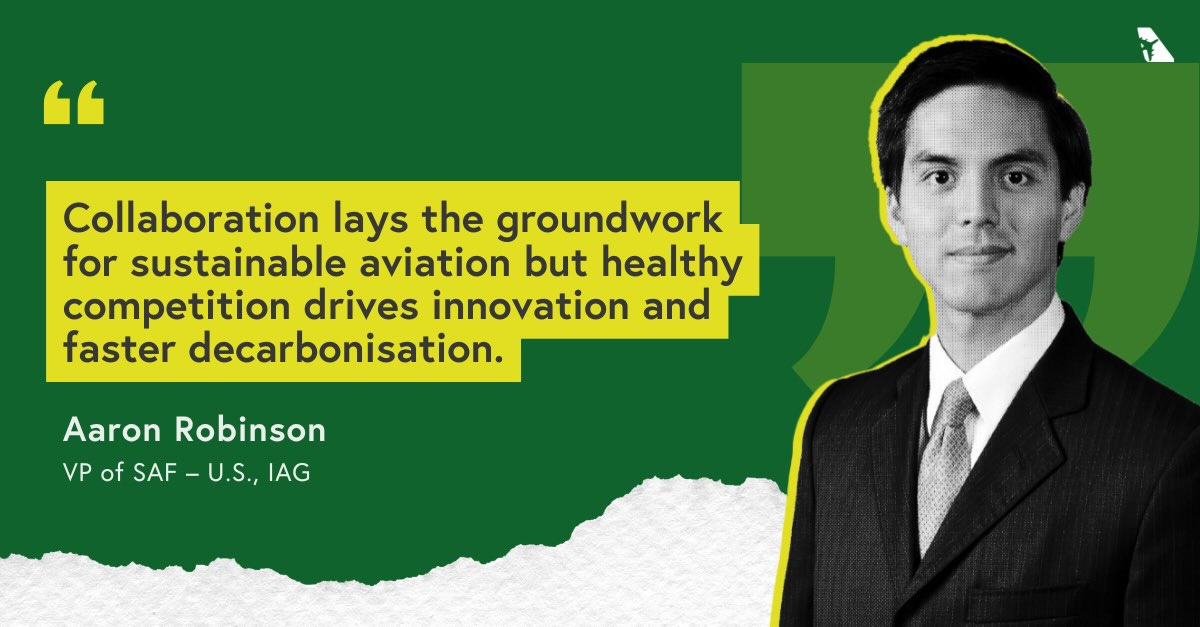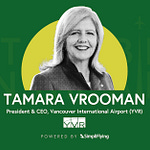In this episode of our ‘Sustainability in the Air’ podcast, Aaron Robinson, Vice President of Sustainable Aviation Fuel (SAF) at the International Airlines Group (IAG), speaks with SimpliFlying CEO Shashank Nigam and shares the airline group’s journey to becoming the global leader in SAF use.
Robinson brings a unique transatlantic perspective, having worked at United Airlines in the US before leading SAF efforts across IAG’s portfolio of European carriers, including British Airways, Iberia, and Aer Lingus. His research reveals that over half the world’s airlines have yet to adopt SAF, despite mounting pressure to decarbonise.
Note: This interview was recorded in August 2024. For the latest figures on SAF use, follow Robinson’s ongoing LinkedIn series. You can read the first post here.
IAG is one of the visionary companies featured in our new book Sustainability in the Air: Volume Two. You can learn more about the book and order a copy here.
Here are the key highlights of the conversation:
IAG’s strategies for achieving top-three global SAF usage (3:12)
Regional disparities: Europe vs North America in SAF adoption (6:32)
Safety culture as a barrier to innovation and first-mover adoption (9:44)
The greenwashing trap: how KLM’s leadership became a cautionary tale (22:38)
Book-and-claim systems for optimising SAF deployment globally (30:56)
Competition vs collaboration: finding the right balance for progress (38:35)
Rapid Fire! (41:52)
Keep reading for a detailed overview of the episode.
Why widespread SAF adoption matters for aviation’s future
SAF represents aviation’s most immediate pathway to significant emissions reductions, yet adoption remains frustratingly slow across much of the sector.
Robinson’s research reveals a stark reality: in 2023, 52% of airlines did not use any SAF, highlighting a fundamental challenge in the industry’s journey toward net-zero emissions by 2050.
The implications of this slow adoption extend beyond individual airline sustainability goals. “In the long run, if half the industry decarbonises and the other half does nothing, we still have a problem—not just for the industry, but for the planet as a whole,” says Robinson. This uneven progress also threatens to undermine collective climate commitments and risks creating competitive distortions between early and late adopters.
Robinson emphasises that achieving meaningful climate impact requires industry-wide transformation. The current trajectory, where SAF represents just 0.21% of global fuel consumption, demands exponential growth. “We have to get to 10% by 2030,” he notes, describing the steep curve required. Reaching this ambitious target necessitates engaging the broader industry, not just the small group of early movers, to take meaningful action.
4 takeaways from the conversation
1. Finding the right balance: competition vs collaboration
Accelerating SAF adoption requires more than cooperation; it demands a strategic blend of collaboration and competition, both of which Robinson sees as essential to driving meaningful progress.
This balance helps resolve two common challenges: the collective action problem that often slows infrastructure development and the lack of urgency among airlines when adoption is left entirely to voluntary action.
Collaboration alone, Robinson warns, can enable free-riding. “That’s what you see with the 55% of airlines globally that haven’t used any SAF whatsoever,” he says. “They’re free-riding on the other 45%.”
However, unchecked competition can lead to greenwashing, making it essential, Robinson argues, to have clear structures and standards grounded in collaboration. Even so, he maintains that it’s competition that ultimately drives performance and accountability.
For Robinson, the path forward is clear: true progress requires both collaboration and competition, not one at the expense of the other.
2. How regulatory backlash stifles progress
Greenwashing accusations and regulatory crackdowns can have an unintended consequence: discouraging genuine sustainability efforts across aviation, says Robinson. He also sees this as a significant barrier to accelerating SAF adoption and broader decarbonisation efforts.
Robinson cites the greenwashing case against KLM as a prime example. “It’s a real travesty that they ended up in the headlines and were effectively penalised for doing meaningful work, and talking about it,” he says. He details KLM’s substantial contributions: one of the world’s first SAF flights, the first global investment by an airline in a SAF producer, and the creation of corporate partnerships to co-fund SAF purchases. “They even operated the world’s first power-to-liquid flight,” he adds.
KLM’s sustainability efforts drew legal and regulatory scrutiny, which Robinson suggests has made some airlines more cautious about public communication. This caution, he notes, may be weakening the public support and political will needed to scale sustainable solutions.
He argues that while some regulatory oversight is necessary, recent rulings, particularly those in the Netherlands and UK, have gone too far. “If you can’t describe anything as sustainable, even when it’s part of government policy, then it becomes almost impossible to communicate progress or drive demand,” he explains.
3. Why Europe leads in SAF adoption
The contrast in SAF adoption between European and North American airlines reflects deeper cultural and policy differences in how sustainability is prioritised. Drawing on his experience, Aaron Robinson offers insight into the regional dynamics behind this uneven global progress.
“In Europe, sustainability is fundamentally more important and significantly more prioritised,” Robinson notes.
This cultural emphasis drives not only stronger climate policies but also influences corporate behaviour. “Companies follow through on those policies because they see the demand from both their customers and employees,” he adds.
Policy frameworks further reinforce these cultural divides. European carriers benefit from a range of supportive measures, including national-level SAF incentives, emissions trading schemes, and airport-specific programmes like Heathrow’s. These tools create a financial rationale for adopting SAF, making it not just environmentally sound but economically practical.
4. Making SAF economically viable
IAG’s experience in scaling SAF adoption illustrates how airlines can build a viable business case for cleaner fuels by combining regulatory incentives, market dynamics, and strategic partnerships. According to Robinson, this multifaceted approach is essential for making SAF more accessible, despite its current price premium.
Robinson attributes IAG’s success in part to a supportive policy environment in the UK and Europe. National-level SAF incentives, emissions trading schemes, and airport-specific programs, such as those at Heathrow, combine to strengthen the economic case for adoption.
A key part of IAG’s strategy also involves working with corporate customers to bridge the price gap. “We’ve done a great deal of work with companies like DHL, Microsoft, and Kühne + Nagel that have helped fund that [price] difference [between SAF and conventional fuel],” says Robinson. “These partnerships have made it extremely affordable for us to decarbonise,” he adds, as corporate clients contribute to SAF costs to meet their own climate targets.
However, Robinson is realistic about the limitations of this approach. “[Corporate partnerships are] not going to be an unlimited well,” he cautions. “It helps jumpstart the industry, but in the long term, we need to bring those premiums down—through scaling up, efficiencies, and innovation.”
Get our new book
Our new book Sustainability in the Air: Volume Two is now available for purchase on Amazon. Learn more about the startups, strategists, and sceptics working to close the gap between growth and green ambition.
‘Sustainability in the Air’ is the world’s leading podcast dedicated to sustainable aviation. Through in-depth conversations with top aviation leaders, we break through the clutter and provide a clear roadmap for a net-zero future.














